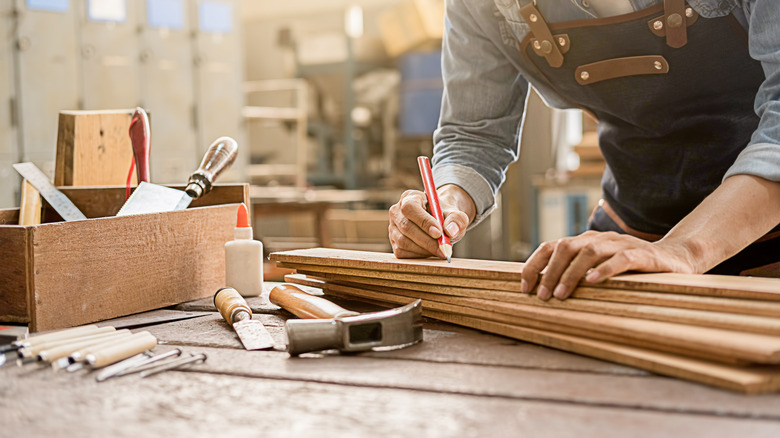TikTok's DIY Folding Workbench That Will Save You Space In The Garage
We may receive a commission on purchases made from links.
Any home workshop for DIY or household projects requires both functionality and durability. While needs may vary depending on the kinds of projects you do, general considerations include space, durability, and weight requirements that make the perfect workbench. Unless you have a dedicated workshop space, most at-home work areas are in spaces that do double duty, like well-organized garages and basements, where room for working and storage is at a premium. TikTok users like @howidothingsdiy have been showing off their ingenious DIY methods — using lumber, plywood, and heavy-duty hinges — to create a variety of workbench configurations that simply fold up against the wall when not in use.
The countertop materials for these projects can range from 2x4s and plywood to repurposed solid core wood doors, and even a premade countertop is an option. Especially if you work with heavy tools or supplies, don't forget about the weight limit of your under-bench supports as well as the thickness and durability of your counter material. If the hinges or legs do not hold the table surface in an upright position on their own, you can use a hook and eye closure like this kind from Amazon at either end to keep it secured.
Options for a DIY folding workbench
The simplest DIY workbench uses a Home Depot precut countertop attached to several heavy-duty shelf bracket hinges — like these from Amazon – that support the shelf from underneath. To install, you simply need a single board cut to the length of your counter attached to the studs in the wall. The brackets screw into the board on the wall and into the underside of the countertop. The hinges can accommodate up to 300 pounds of weight.
Other TikTok users' versions of this DIY are available online — this one from @therealjeffreyyscott includes a similar approach, but instead uses door hinges to attach the countertop to the board along the wall. Many of these designs place the weight of the table on folding legs, which can be created with 2x4s cut to the desired height of the table. You can use single boards that attach with door hinges to the bottom of the table to fold out to the floor or create a frame of legs that attaches to the wall itself and folds out like doors to support the underside of the table.
Price will vary depending on the size of the counter, the countertop material, and the amount of lumber you need to form the legs, but the project could cost as little as $100 or less. This DIY approach is much more budget-friendly than purchasing tables with premade metal legs or brackets that work similarly and cost several hundred dollars.
